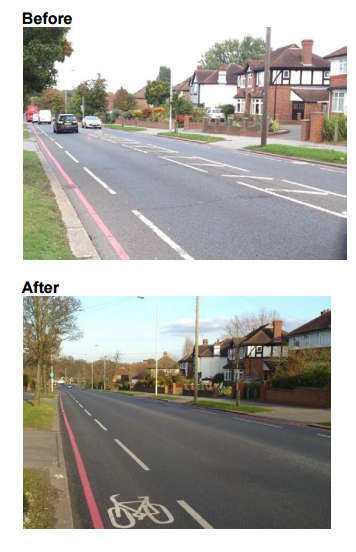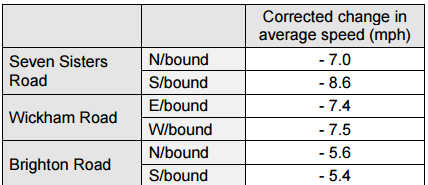Markings could be removed from selected roads in Norfolk following trials in London that showed with ‘confidence’ traffic speeds had been ‘significantly’ reduced.
In 2014 Transport for London (TfL) launched three pilot projects whereby centre lines were not reinstated in short sections of road after resurfacing, totalling around 1 mile.
TfL found that in two sites - the A503 Seven Sisters Road in Haringey and Wickham Road in Croydon – the testing showed a 95% statistical confidence level that there was a ‘significant change’.
On a third site the A23 Brighton Road in Croydon, this dropped slightly for south bound traffic to ‘a statistically significant change at 90% confidence interval’.

Image from TfL report: Site B Wickham Road, Croydon
Based on research that average speeds actually increased when a new surface was provided, TfL found that speeds had been reduced by up to 8.6mph.
Experts at the transport research group TRL estimate that a 5% reduction in accident frequency can be expected per 1mph reduction in average speed.
The sites have been entered into the Traffic Accident Data System (TADS) and will be monitored for any trends after 3 years of data has been obtained.
Alan Bristow, director of road space management at TfL said: ‘The results were positive and the trials sites are monitored closely to understand the longer term effects, and we will take account of the findings of this research in the development of future schemes.’
However he added ‘there are no plans for any widespread removal of road markings’.
An initial TfL report on the pilot schemes states: ‘Centre line removal introduces an element of uncertainty, which is reflected in lower speeds.

TfL's trials initial results, allowing for speed increase after resurfacing
‘Although not identifiable in the data, it was noted on site that speeds of individual vehicles appeared to be particularly lower when they were passing other vehicles travelling in the opposite direction. This supports the theory that uncertainty and additional cautiousness is responsible for the speed reduction.’
The TfL report also references a study conducted by Wiltshire County Council between 1997 and 2003, stating the study found that ‘not reinstating the centre lines on a number of resurfacing sites led to a reduction in injury collisions and traffic speeds’.
Norfolk County Council has confirmed that it is considering a similar scheme and has been removing centre lines from selected roads for 15 years.
Department for Transport (DfT) guidance recommends omitting centre lines when the carriageway is rural and less than 5.5 metres.
The DfT guidance document for road markings – Chapter 5 of the Traffic Signs Manual – details different types and dimensions of lines but does not state that they must be used, TfL said.
A spokeswoman for Norfolk County Council told Transport Network that its scheme was still in development and the council is in talks with the DfT about government funding.
There is council member support for the idea, which would be trialled on a 40mph road, although officials added the scheme was not specifically about white line removal.
The council said it removed centre lines in locations that have the right characteristics and community support as a routine part of network management.
Tracy Jessop, assistant director of highways and transport at Norfolk, said: 'We follow national guidance when designing any scheme and know the removal of a centre white line wouldn’t be suitable on main roads with high traffic flows, but it can work well on certain quieter roads which already enjoy lower traffic speeds.
'Fewer road markings can improve street safety for everyone by making drivers more cautious, increasing awareness and lowering speeds. This is a routine part of our network management approach to support objectives to reduce congestion, and improve journey time reliability and safety. We have recently recorded our lowest ever number of fatal accidents in the county.'
The road marking industry has reacted with concern to both the practice and theory behind these schemes.
George Lee, chief executive of the Road Safety Markings Association, told Transport Network: ‘This is nothing new. This approach was looked at by a number of counties about 10 years ago and was dispatched as being unproductive. There should be no uncertainty in the road environment. Drivers should travel in a standardised environment where they know exactly what to expect.
‘Research shows road markings are absolutely critical to the safety of all road users and the free movement of traffic.
‘The Government has said they want to crack down on cowboy insurance claims on our roads but these schemes would create a wild west.’
He added that certain driverless car models needed road markings to navigate and plans to remove them would set the country back in this key area for the future.